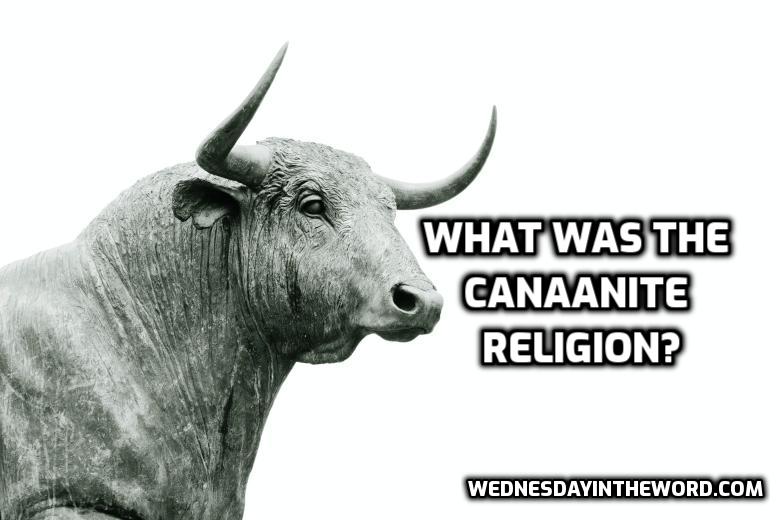“Canaanite” refers to the group of polytheistic people living in the historical region of Israel and Palestine at the time of the Old Testament.
Their mythology centered around three primary exploits of Baal: 1) he established himself as the god of supreme power within the pantheon; 2) he built the temple with his victory over Yam; and 3) in the “Baal cycle”, struggled with, succumbed to, and ultimately escaped from the clutches of Mot.
Importance of Seasons
In the ancient world, life revolved around the seasons. A prolonged winter and rainy season was one of the basic necessities of life.
Their year was divided into wet and dry seasons. The rainy season began in the fall during October-November. During February and March, everything blossoms. Near the end of March, the hot desert winds (called the “khamsin” or “sirocco”) began to blow and everything dried rapidly.
Summer was a period of drought and sterility with almost no rainfall. The springs and small streams ran dry. Only large rivers like the Jordan continue to flow. Only crops near a water source or irrigated from wells and cisterns continue to grow.
Most of the myth and ritual of the ancient Near East is preoccupied with the regular alteration of the seasons. Their gods were nature deities who derived their existence (and often their names) from the forces of nature. Almost all of their mythology is concerned with struggle and conflict among these forces.
Canaanite myth depicted this struggle in nature in terms of violent and lusty conflict among the gods. Canaanites acted out these myths in regular seasonal ceremonies. They believed that enacting these myths would ensure the regular succession of seasons, producing rain and fertility. These fertility rights gave them some feeling of control over their environment.
Typically, the priests of Baal performed these myths vicariously as representatives of the people, but sometimes the people themselves participated. What the gods and heroes did in the myth, the priests and people did in reality. The mythological descriptions of racy escapades of Canaanite gods and goddesses are thus an accurate portrayal of social and moral conditions in Canaan.
Most of our knowledge of the Canaanite god Baal comes from the Ras Shamra tablets, discovered in northern Syria in 1958, which record fragments of a mythological story known as the Baal Cycle.
The Baal Cycle
Baal is normally depicted as brandishing a club in one hand and a stylized lightening bolt in the other. On his head he wears a helmet of horns, suggesting his association with the bull, a symbol of fertility and potency.
Baal is the great storm god who drives the clouds across the sky and lets his voice be heard in the thunder. He is often called the “rider of the clouds.” Baal also sends the dew, a precursor to the rainy season. One of is daughters is called Talliya (which means dew) and another daughter is Padriya (fatness or plenty).
In violent conflict, Baal drives off Mot, the god of the dry season, and brings rain and fertility to the land.
Mot, whose name means “death”, is the god of drought and sterility. He presides over the dry season and functions as Baal’s chief antagonist. When Mot demands that Baal descend into the underworld, Baal meekly submits.
However, before Baal leaves he lies with a heifer who conceives and bears a child. By his last act, Baal ensures that fertility will not perish entirely during his absence. (Most scholars think priests and Baal worshipers practiced bestiality as part of their fertility cult.)
With Baal’s death, Eli, the chief god, goes into mourning. Eli descends from his throne and sits in sackcloth and ashes on the ground. He lacerates himself, cutting his face, arms and back. Anat, Baal’s consort, also mourns and copies Eli’s self-mutilation.
Eli & Anat go down into the earth and retrieve Baal. She calls to the sun goddess, Shepesh, who nightly descends into the netherworld (as she sinks into the sea). Together they bring the body of Baal to the northern heights where they weep over him. Then they offer sacrifices of six different kinds of animals.
Eli cries out to Asherah, his mistress, and asks her which of his sons is fit to rule in Baal’s absence. She suggest Attar (Ashtar) – a name which seems to be related to artificial irrigation.
However, when Attar ascends to the heights to sit on Baal’s throne, his feet do not reach the footstool, nor he head the top of the throne. Only Baal can bring fertility.
Anat seeks out Mot and beg’s for Baal’s return. Mot refuses. Anat the seizes Mot, cleaves him with a sword and plants him in a field.
In a dream, Eli sees the return of Baal and knows that he lives. Somehow Baal is found and brought back to life. (We do not know how or where because this portion of the text is damaged.)
Baal now meets Mot in bloody conflict, falling on each other like wild animals. The struggle is short. Shephesh, the sun goddess, aids Baal. Mot’s time is over and Baal is once more installed on his throne.
The text that follows is badly damaged, but it appears that shortly after Baal’s return, a bull calf is born to him. In one of the most explicit accounts of sexuality found in ancient literature, Baal then scatters his seed and fertility is returned to the earth.
The fact that Baal is re-established on his throne guarantees rain and fertility for the year ahead.
It probably goes without saying that myth played no part in the faith of Israel. Fertility was always the result of God’s blessing, conditioned on Israel’s obedience and God’s loyalty to the covenant. YHWH alone sent the rain and produced fertility. Israel’s preservation was a spiritual and moral issue, not one of ritual and ceremonial enactment of myths.
See: Deuteronomy 28:1-14
Dictionaries & Encyclopedias
- 1911 Encyclopedia Britannica: Canaanites
- International Standard Bible Encyclopedia: Canaan; Canaanites
- Kitto’s Popular Cyclopedia of Biblial Literature: Canaan; Canaan Land Of; Canaanites
- McLinktock & Strong: Canaainite; Canaan
- The 1901 Jewish Encyclopedia: Canaan; Canaanites, The
- American Tract Society Bible Dictionary: Canaan; Canaanites
- Baker’s Evangelical Dictionary of Biblical Theology: Canaan
- Easton’s Bible Dictionary: Canaan; Canaanite; Canaanites
- Fausset’s Bible Dictionary: Canaan
- Holman Bible Dictionary: Canaan, History and Religion Of
- Hastings’ Dictionary of the Bible: Canaan; Canaanites
- Morrish Bible Dictionary: Canaan; Canaan, Land Of; Canaanite, The; Canaanites, The
- Smith’s Bible Dictionary: Ca’naan; Ca’naan, the Land Of; Ca’naanite, The,; Ca’naanites, The,
- Bible-History Online:
- Wikipedia: Ancient Canaanite religion
- Wikipedia: Canaan
- 1911 Encyclopedia Britannica: Baal
- International Standard Bible Encyclopedia: Baal (1); Baal (2); Baal (3)
- Kitto’s Popular Cyclopedia of Biblical Literature: Baal
- McClintock and Strong: Baal
- The 1901 Jewish Encyclopedia: Ba’al; Ba’al and Ba’al-Worship
- American Tract Society Bible Dictionary: Baal
- Baker’s Evangelical Dictionary of Biblical Theology: Baal
- Easton’s Bible Dictionary: Baal
- Fausset’s Bible Dictionary: Baal (1); Baal (2); Baal (3)
- Holman Bible Dictionary: Baal
- Hastings’ Dictionary of the Bible: Baal; Baal (1)
- Morrish Bible Dictionary: Baal
- Smith’s Bible Dictionary: Ba’al; Ba’al,; Ba’al
- Bible-History Online: Baal
Photo by Hans Eiskonen on Unsplash

